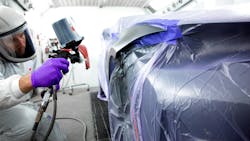An on-the-spot evaluation is any instance in which a technician has to make a decision for some repair operations that are unique to that vehicle’s needs.
With the increasing complexity of vehicles, these kinds of evaluations are becoming more prevalent than ever before. Danny Gredinberg, administrator for the Database Enhancement Gateway and a training facilitator for Collision Advice, says on-the-spot evaluations are almost essential for every repair and every step of the process.
“That mindset should always be kind of floating, you know, at every point of the damage assessment,” Gredinberg says. “As you're adding lines onto that estimate repair plan, keep in mind, not everything generates or populates as one would think. So, therefore, you're having to kind of click on an operation, confirm it is, in fact, populating a time that you see on the screen. You're always kind of having to keep that mindset as you're going along throughout the process.”
The Problem
On-the-spot evaluations are a simple process, but they require a level of baseline knowledge and awareness to be the most effective.
Gredinberg says that an all-too-common issue that repairers face when a vehicle rolls into their shop is that estimating systems such as CCC Intelligent Solutions, Mitchell and Solera (Audatex) can’t account for every variable in a repair.
For as powerful and useful as those tools might be, they’re not going to be able to figure out what condition the vehicle is in when it enters the shop; they won’t be able to tell whether or not the electrical systems are working, what scan tool (or tools) will be necessary, which ADAS systems are affected, and much more.
“Those operations, many times, are not defined by a published time because of variables known in the environment,” Gredinberg says. “There's just no way for an information provider to confidently say, okay, to scan this car, it's always going to be this set time in a collision repair center.”
The Solution
The solution, then, according to Gredinberg, is an on-the-spot evaluation.
Gredinberg uses the issue of blending in refinishing and a recent Society of Collision Repair Specialists (SCRS) study as a prime example. For years, the industry has been at an impasse about how much time is needed to perform a blend on a panel.
“Information providers used to provide a formula at the time stating if you are going to blend-refinish a panel, you would receive a calculation of 50% [for two-stage] of the refinish time that was allowed in the system,” he says. “The industry was at a disagreement, and there's just no way you can perform this operation at that time given.”
Because of that, SCRS performed a study in which they found that there were too many variables for blending to be distilled down to a formula and that on average, blending a panel takes close to 32% more time than does a full refinish. CCC and Solera removed those formulas from their tools, and now when a vehicle has sections that need to be blended, those estimating platforms recommend on-the-spot evaluations for each scenario.
“The repairer can assign a time that they feel is reasonable to perform that operation,” Gredinberg says, “but also keep in mind that there's another entity typically involved, which is an insurance company, which can also have input on what that time should be as well, right? I mean, this on-the-spot evaluation could be from two angles over a single car in question.”
Gredinberg says scanning operations are another common example of when on-the-spot evaluations would be necessary.
“Every car in a collision will require a scanning operation to pre-scan and process scan,” he says. “Since none of the manufacturers define what that time is or none of the information providers define that time, that's going to be a definitive situation where a shop can determine an on-the-spot evaluation. It's really going to come down to the shop making that final choice.”
The Aftermath
As Gredinberg mentioned, your shop is rarely the only party that is dealing with a customer during the repair process.
On-the-spot evaluations require a strong technical understanding of each aspect of the repair, and it also requires being able to communicate that understanding to both insurers and your customer.
Gredinberg warns that there will always be pushback when you’re advocating for more time for repairs, but that having the knowledge to accurately and confidently defend your position is essential.
“Being technically savvy and knowledgeable is a huge deal,” Gredinberg says. “If you don't understand the process with confidence, and you're being questioned, the hesitations can create fear and anxieties, and you won't be able to stand by what you're actually billing for.”
The Takeaway
On-the-spot evaluations are powerful and relatively simple processes to implement in your shop, but they require a strong understanding of every part of the repair procedure to work effectively.
Gredinberg says DEG provides resources to help with on-the-spot evaluations, and other organizations such as SCRS have estimator guides that walk through specific instances of different evaluations.
Overall, though, having confidence in your knowledge and a deep understanding of the repair process is the key to successfully using on-the-spot evaluations.
“Continue researching those OEM procedures. Those procedures are the bible of the repair, more than anything else,” Gredinberg says. “And if the procedure for the manufacturer calls for that operation to be completed, it is our moral obligation to educate ourselves, inform the customer, get the authorization and perform that operation to ensure safe and proper repair.”
One-minute Quiz: Collecting for Short Pays
About the Author

Noah Brown
Noah Brown is a freelance writer and former senior digital editor for 10 Missions Media, where he facilitated multimedia production several of the company's publications.
